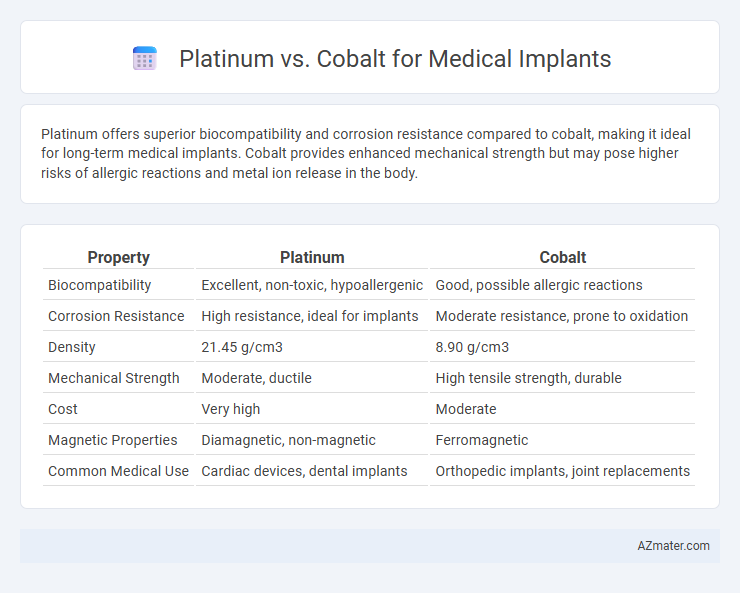Platinum offers superior biocompatibility and corrosion resistance compared to cobalt, making it ideal for long-term medical implants. Cobalt provides enhanced mechanical strength but may pose higher risks of allergic reactions and metal ion release in the body.
Table of Comparison
| Property | Platinum | Cobalt |
|---|---|---|
| Biocompatibility | Excellent, non-toxic, hypoallergenic | Good, possible allergic reactions |
| Corrosion Resistance | High resistance, ideal for implants | Moderate resistance, prone to oxidation |
| Density | 21.45 g/cm3 | 8.90 g/cm3 |
| Mechanical Strength | Moderate, ductile | High tensile strength, durable |
| Cost | Very high | Moderate |
| Magnetic Properties | Diamagnetic, non-magnetic | Ferromagnetic |
| Common Medical Use | Cardiac devices, dental implants | Orthopedic implants, joint replacements |
Introduction to Medical Implant Materials
Platinum and cobalt are prominent materials used in medical implants due to their biocompatibility and mechanical strength. Platinum offers exceptional corrosion resistance and is highly inert, making it suitable for sensitive implant environments such as cardiovascular devices. Cobalt-based alloys provide superior wear resistance and high tensile strength, ideal for load-bearing orthopedic implants like hip and knee replacements.
Overview of Platinum in Medical Implants
Platinum is extensively used in medical implants due to its exceptional biocompatibility, corrosion resistance, and stable electrical conductivity, making it ideal for cardiovascular stents, pacemaker electrodes, and neural implants. Its inert nature reduces the risk of adverse tissue reactions and ensures long-term durability within the human body. Compared to cobalt, platinum offers superior resistance to oxidation and metal ion release, contributing to safer and more reliable implant performance.
Overview of Cobalt in Medical Implants
Cobalt is a widely used metal in medical implants due to its exceptional strength, wear resistance, and biocompatibility, making it ideal for joint replacements and dental devices. Its alloys, such as cobalt-chromium, offer superior corrosion resistance and mechanical stability under high stress environments. The metal's ability to integrate well with bone tissue while minimizing allergic reactions contributes to its preference in long-term implant applications.
Biocompatibility: Platinum vs Cobalt
Platinum exhibits superior biocompatibility in medical implants due to its inertness and resistance to corrosion, significantly reducing the risk of adverse tissue reactions and immune responses. Cobalt alloys, while strong and durable, can release metal ions that may cause inflammation or hypersensitivity in sensitive patients. Therefore, platinum's compatibility with biological tissues makes it an ideal choice for long-term implants where minimal biological interference is critical.
Corrosion Resistance and Longevity
Platinum exhibits superior corrosion resistance compared to cobalt, making it highly suitable for medical implants exposed to bodily fluids and harsh physiological environments. The inert nature of platinum ensures minimal ion release and enhances biocompatibility, significantly extending implant longevity. Cobalt alloys, while durable and strong, are more prone to corrosion and potential metal ion leaching, which can impact long-term implant performance and patient safety.
Mechanical Strength and Durability
Platinum exhibits excellent corrosion resistance and biocompatibility but has lower mechanical strength compared to cobalt alloys, making it less ideal for load-bearing medical implants. Cobalt-based alloys, such as cobalt-chromium, offer superior tensile strength, hardness, and wear resistance, ensuring enhanced durability in orthopedic and dental implants. These mechanical properties make cobalt alloys preferred for implants requiring long-term structural integrity under high stress conditions.
Allergic Reactions and Toxicity Concerns
Platinum is favored in medical implants due to its excellent biocompatibility and low risk of allergic reactions, making it suitable for patients with metal sensitivities. In contrast, cobalt-based alloys, while strong and wear-resistant, are associated with higher incidences of hypersensitivity and potential cytotoxicity due to cobalt ion release. Careful evaluation of patient allergies and long-term toxicity risks is essential when choosing between platinum and cobalt for implants to ensure safety and implant longevity.
Cost Comparison: Platinum vs Cobalt Alloys
Platinum alloys used in medical implants generally have a higher material cost compared to cobalt alloys due to the rarity and purity requirements of platinum. Cobalt alloys offer a cost-effective alternative with strong mechanical properties suitable for load-bearing implants, often leading to lower overall manufacturing expenses. Budget-sensitive medical applications favor cobalt alloys for their balance of performance and affordability, whereas platinum is reserved for specialized uses demanding exceptional biocompatibility.
Applications in Specific Medical Devices
Platinum is predominantly used in cardiac pacemakers and neurostimulation devices due to its excellent biocompatibility and corrosion resistance. Cobalt alloys find widespread application in orthopedic implants such as hip and knee replacements because of their superior mechanical strength and wear resistance. The choice between platinum and cobalt depends on device-specific requirements, with platinum favored in electrical stimulation components and cobalt preferred for load-bearing implants.
Choosing the Right Material: Key Considerations
Platinum offers exceptional biocompatibility and corrosion resistance, making it ideal for long-term medical implants that require stability in the human body. Cobalt alloys provide superior mechanical strength and wear resistance, which are crucial for load-bearing implants such as joint replacements. Choosing between platinum and cobalt depends on the specific implant application, balancing factors like biocompatibility, mechanical properties, and the risk of allergic reactions.

Infographic: Platinum vs Cobalt for Medical Implant
 azmater.com
azmater.com